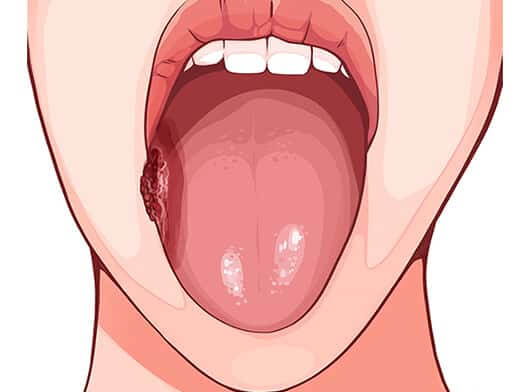- Surgery
- Radiation
- Medical Oncology
- Factors considered to decide on the course of treatment include overall physical health, the type and stage of cancer, the probability of curing the disease, and the impact of treatment on functions like speech, chewing, and swallowing. Surgical options for oral cancers are based on the location of cancer.
- Surgical excision for small tumours - Small tumours of the oral cavity can be quickly and successfully treated by surgical excision. The advantage of treating early-stage cancer with surgery is that it is completed quickly and usually requires only a few days of hospital stay.
- Surgical excision of advanced tumours - When a patient undergoes surgery for oral cancer, the surgeon removes the tumour with some of the adjoining healthy tissues. Complete surgical clearance of the tumour is assessed with the help of the pathologist, who examines the removed tissue at the time of surgery itself (Frozen Section) to determine the complete removal of the malignant tumour.
- TONGUE - If the cancer is located in the tongue, based on the extent of involvement of the tongue, different types of resections are performed:
- Partial glossectomy - a small part of the tongue is removed.
- Hemiglossectomy - half of the tongue is removed.
- Subtotal glossectomy - more than half of the tongue is removed.
- Total glossectomy - entire tongue is removed
- Reconstructive surgery is immediately done to help the patient improve speech and swallowing. Reconstruction is based on the extent of resection. In the case of smaller defects, usually, primary closure of the tongue is done, while in the case of larger defects, microvascular reconstruction using a free flap taken from the thigh is the best option.
- BUCCAL MUCOSA AND ALVEOLUS
- Wide Excision - For cancer involving the buccal mucosa, wide excision of the same is done with the removal of a part of / half of the mandible (lower jaw) or maxilla (upper jaw) with the involved gingiva (gums).
- Alveolectomy -if the upper or lower alveolus is involved, the respective jaw bones are removed with or without a portion of the buccal mucosa.
- The lower jaw bone (mandible), which gives shape to the lower part of the face, is essential for chewing food. This bone is removed when the tumour invades it.
- Resection of the mandible varies in each individual based on the extent of cancer. It may be a-
- Marginal mandibulectomy - the upper part of the mandible is removed, retaining the contour of the jaw. In this case, there is no need for reconstruction.
- Segmental mandibulectomy - a segment of the mandible is removed.
- Hemimandibulectomy - half of the mandible is removed.
- Reconstruction of Mandible - If the bone is not reconstructed, chewing food is difficult, and the facial appearance also changes. Currently, the lower jaw is reconstructed with a bone from the leg (fibula) using microvascular technique. It helps in retaining the facial contour, and the patient is able to chew well with the remaining teeth.
- Resection of Maxilla might involve removing a part of the tooth socket. It may be:
- Infrastructure maxillectomy - removal of the lower part of the maxilla, which is the bone that gives contour to the cheek. It may lead to defects in the palate.
- Reconstruction of Maxilla - If the bone is not reconstructed, it causes difficulty in swallowing. Reconstruction of the maxilla is done using microvascular techniques or by using a dental obturator. Teeth can also be fixed onto titanium screws that are implanted into the bone either at the time of the primary surgery or later (known as Osseo-integrated dental implants).
- Early oral cavity tumours can be treated effectively with either external beam radiotherapy or brachytherapy.
- Locally advanced cancers are either treated with concurrent radiotherapy and chemotherapy or undergo radical surgery followed by radiotherapy and chemotherapy.
- There are various high-precision irradiation techniques like IMRT (intensity modulated radiotherapy), IGRT (image guided radiotherapy), and RapidArc or Proton beam therapy to treat these tumours. High precision irradiation techniques can reduce side effects like xerostomia (dryness in the mouth), and difficulty in swallowing and result in a better quality of life.
- In selected cases, Brachytherapy is suggested. This reduces the duration of radiotherapy while administering the necessary quantum of radiation for treatment.
- Chemotherapy
- Chemotherapy uses drugs to destroy cancer cells. The indication for chemotherapy is based on the stage of cancer and risk factors.
- Few patients may require chemotherapy after surgery which helps to kill any residual cancer cells. It is also indicated in cases when the disease has spread to other parts of the body or when there is a high chance of recurrence.
- Sometimes chemotherapy is combined with radiation therapy.
- The indication for targeted therapy is based on molecular changes in the cancer cell. This is usually combined with chemotherapy and may be an option in selected cases. In the case of recurrent disease, based on the molecular alterations noted in the tumour, specific targeted therapy is also an option.
- Immunotherapy is a drug treatment that uses the immune system to fight cancer. The indication for immunotherapy is based on immune-histochemical tests and molecular tests in advanced disease and recurrence. Generally, patients tolerate immunotherapy well.



.png)
